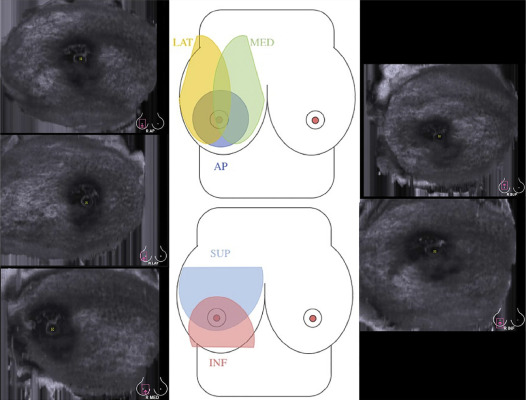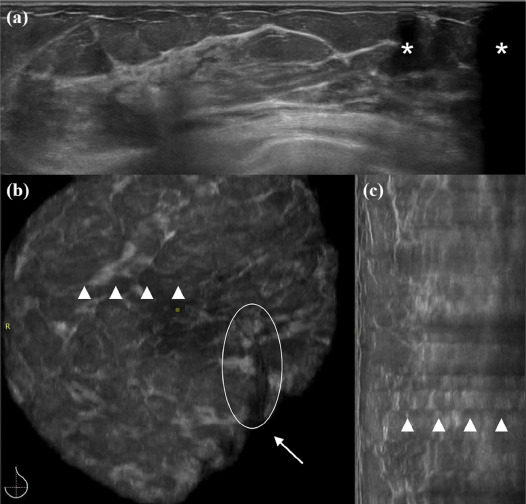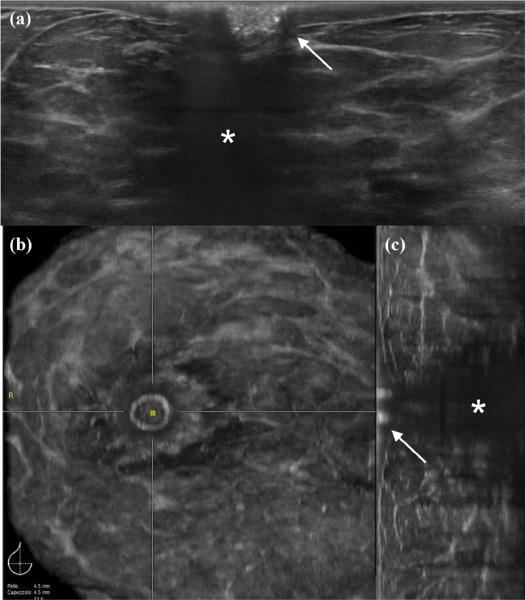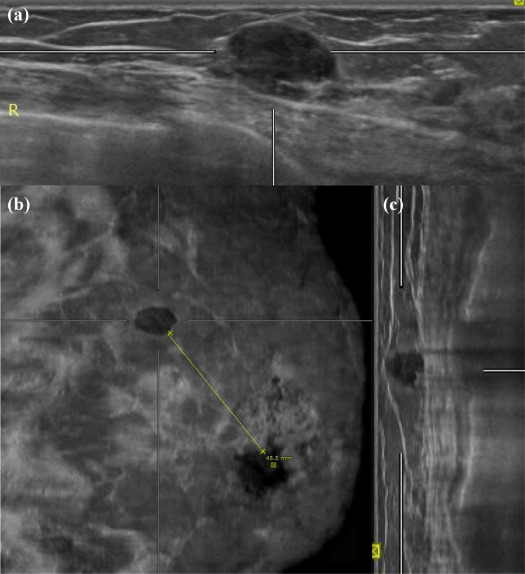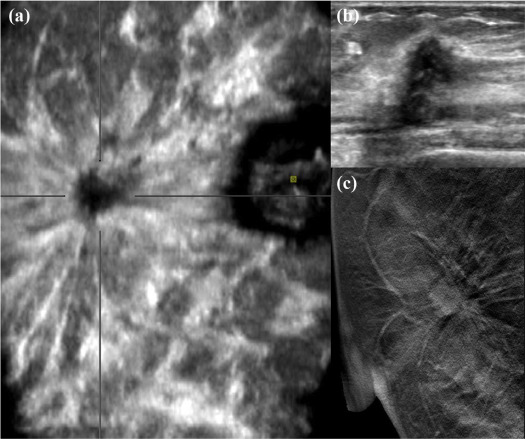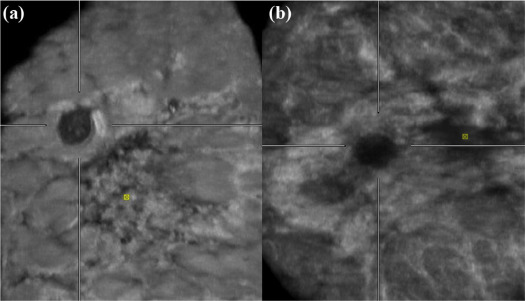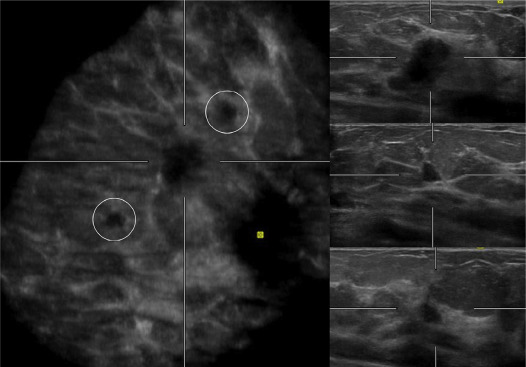Automated breast ultrasonography (ABUS) is a new imaging technology for automatic breast scanning through ultrasound. It was first developed to overcome the limitation of operator dependency and lack of standardization and reproducibility of handheld ultrasound. ABUS provides a three-dimensional representation of breast tissue and allows images reformatting in three planes, and the generated coronal plane has been suggested to improve diagnostic accuracy.
This technique has been first used in the screening setting to improve breast cancer detection, especially in mammographically dense breasts. In recent years, numerous studies also evaluated its use in the diagnostic setting: they showed its suitability for breast cancer staging, evaluation of tumor response to neoadjuvant chemotherapy, and second-look ultrasound after magnetic resonance imaging.
The purpose of this article is to provide a comprehensive review of the current body of literature about the clinical performance of ABUS, summarize available evidence, and identify gaps in knowledge for future research.
Introduction
Handheld ultrasound (HHUS) is an essential diagnostic tool to detect and characterize breast lesions, complementary to digital mammography (DM). In particular, HHUS is mandatory to confirm the finding and to guide biopsy of the suspicious lesion when an abnormality is evidenced on DM (Breast imaging-reporting and data system [BI-RADS] 4–5) .
HHUS can also depict breast cancers, which are at the same time occult on DM, especially in dense breasts (American college of radiology [ACR] BI-RADS breast composition category d), where the sensitivity of DM is lower (47.8%–64.4%) .
However, HHUS is operator-dependent, and in such stetting lacks standardization and reproducibility; it also requires considerable physician time for acquisition. Automated breast ultrasonography (ABUS), also known as automated breast volumetric scanner, has been developed to overcome these limitations. ABUS is a new imaging technology based on automated scanning of the breast using ultrasounds with high-frequency broadband transducers. This provides three-dimensional (3D) representation of breast tissue and allows image reformatting in three planes.
Get Radiology Tree app to read full this article<
Get Radiology Tree app to read full this article<
Technology
Get Radiology Tree app to read full this article<
Get Radiology Tree app to read full this article<
Get Radiology Tree app to read full this article<
Get Radiology Tree app to read full this article<
Technique and Interpretation
Get Radiology Tree app to read full this article<
Get Radiology Tree app to read full this article<
Get Radiology Tree app to read full this article<
Get Radiology Tree app to read full this article<
Get Radiology Tree app to read full this article<
Artifacts
Get Radiology Tree app to read full this article<
Get Radiology Tree app to read full this article<
Get Radiology Tree app to read full this article<
Get Radiology Tree app to read full this article<
Get Radiology Tree app to read full this article<
Get Radiology Tree app to read full this article<
Get Radiology Tree app to read full this article<
Diagnostic Performance
Get Radiology Tree app to read full this article<
TABLE 1
Diagnostic Performance of ABUS
Study author Patients (Lesions, BC) Mean age y (range) SE (%) SP (%) FPR (%) FNR (%) PPV NPV Reference standard Comparative accuracy to HHUS Additional relevant findingsChang N.R. (105, 24) 47±14 (20–79) 92.5 63 37.0 7.5 56.41 93.55 Histology or imaging FUP (mean 11.1±10.4 months, range 0–31 months) N.R. Mean diameter of the lesion, surrounding tissue changes and shape of the mass were the final most important factors associated with lesion detectability.Chang 61 (62, 14) 45
(32-62) 71.4 \* 86.1 \* 14.6 28.6 58.8 91.1 Histology or imaging FUP (mean 15 months, range 15–26 months) N. R. The mean time to interpret the 3D ABUS data per breast was 4.5 minutes (range 3.5–7.5 minutes) for reader 1, 4.0 minutes (range 3.0–7.0 minutes) for reader 2, and 5.5 minutes (range 3.5–9.5 minutes) for reader 3.Chen 175 (219, 67) 41.7 (16-71) 92.5 86.2 13.8 7.5 74.7 96.3 Histology or FUP (not specified) N.S. HHUS: SE 88.1%, SP 87.5%, FPR 12.5%, FNR 11.8%, PPV 75.6%, NPV 94.3% There were significant differences between malignant and benign masses with respect to the retraction phenomenon and hyperechoic rim.Cho 141 (150, 60) 46 (25–71) 98.3 † 70.0 † 30.0 1.7 68.6 98.4 Histology or imaging FUP (mean 20 months, range 12–26 months) N.S. HHUS: SE 96.7%, SP 64.4% Interobserver agreements between the four radiologists for final assessment of solid breast masses were similar for 2D and 3D US images ( P > .05).Golatta 42 (N.R., 20) 51 (33-83) 82.0 68.0 12 12 81.31 69 Histology N. R.Golatta 983 (N.R., 119) 55.7 (19–92) 84.0 85.0 15.0 16.0 27.0 99.0 Combination of HHUS, mammography and histology N.R. Fair agreement (k = 0.25–0.31) of ABUS with HHUS and mammography but total agreement rates for dichotomized (benign versus malignant) lesionsJeh 173 (206, 46) 48 (20-80) 88.05 † \* 76.25 † \* 23.75 ‡ 11.95 ‡ 52.25 ‡ 95.95 ‡ Histology HHUS: SE 95.7% ( P > .05), SP 49.4 ( P < .0001) Smaller lesions and lesions with lower final-assessment category were less frequently detected on ABUS ( P < .011 and P < .0001, respectively).Kim 87 (106, 52) N.R. 89.2 79.0 21.0 10.8 81.31 94.1 Histology or imaging FUP (mean 49 months, range 24–126) N.S. HHUS: SE 98.7%, SP 80.1% Final assessment of solid breast masses showed substantial to almost perfect agreement between HHUS and ABUS (k= 0.773±0.104)Kim 38 (66, 50) N.R. 92.0 87.5 12.5 8.0 95.8 77.8 Histology N.S.HHUS: SE 98.0%, SP 62.5% Overall agreement for mass size, shape, posterior features, orientation and BI-RADS category was moderate while the overall agreement for margins was fair (κ = 0.25)Lin N.R. (35, 15) 40.7 (16–78) 100.0 95.0 5.0 0.0 93.7 100.0 Histology N.S. HHUS: SE 100.0%, SP 85.0% Perfect agreement between ABUS and pathological diagnosis (k=0.942)Kotsianos-Hermle 97 (107, 39) 52.4 (21-78) 96.5 92.3 7.7 3.5 N.R. N.R. Histology N.S.HHUS: SE 97.5%, SP 88.5% Correlation was good between ABUS and HHUS for the BIRADS criterion “margins” (k=0.88)Shin 55 (145, 28) 48 (29–69) 96.0 § 91.8 § 8.2 4.0 N.R. N.R. Combination of HHUS, mammography and histology N.S.HHUS: SE 100.0%, SP 93.0% Lesion detection was reliable (92%) only when mean lesion diameter was>1.2 cmWang 213 (239, 85) 43.0±12.5 (11-81) 95.3 80.5 19.5 4.7 73.0 93.3 Histology N.S.HHUS: SE 90.6%, SP 82.5%Wang 155 (165, 103) 43.1±21.2 (23-65) 96.1 91.9 8.1 3.9 95.2 93.4 Histology N.S.HHUS: SE 93.2%, SP 88.7% The stellate margin had a high specificity (98.4%) but a low sensitivity (57.5%), with an accuracy to determine malignant and benign lesions of 73.9%Wojcinski 50 (50, 14) 52 (32-72) 100 52.8 47.2 0.0 45.2 100.0 HHUSWojcinski 100 (100, 18) 52 (19-86) 83.3 78.1 21.9 16.7 N.R. N.R. HHUSSchmachtenberg 28 (39, 15) 44.6 (26-76) 93.3 83.3 16.7 6.7 77.8 95.2 HHUS, MRI and histology (if available) N.S.HHUS: SE 100.0%, SP 83.3%
BC, Breast cancer; FNR, false negative rate; FPR, false positive rate; FUP, follow-up; HHUS, hand-held ultrasound; N.R., not reported; N.S., not significant ( P > .05); NPV, negative predictive value; PPV, positive predictive value; SE, sensitivity; SP, specificity.
Get Radiology Tree app to read full this article<
Get Radiology Tree app to read full this article<
Get Radiology Tree app to read full this article<
Get Radiology Tree app to read full this article<
Get Radiology Tree app to read full this article<
Get Radiology Tree app to read full this article<
Get Radiology Tree app to read full this article<
Get Radiology Tree app to read full this article<
Get Radiology Tree app to read full this article<
Get Radiology Tree app to read full this article<
Interobserver Agreement
Get Radiology Tree app to read full this article<
Get Radiology Tree app to read full this article<
Get Radiology Tree app to read full this article<
Get Radiology Tree app to read full this article<
Indications for ABUS
Get Radiology Tree app to read full this article<
Screening Setting
Get Radiology Tree app to read full this article<
Get Radiology Tree app to read full this article<
Get Radiology Tree app to read full this article<
Get Radiology Tree app to read full this article<
TABLE 2
Studies Comparing Screening Mammography Alone Versus Mammography Plus ABUS
Comparative accuracy (DM+ABUS vs DM alone) Study Study aim Study design Screening US examinations (N°) US-only BC (N°) SE (%) SP (%) DR (per 1000 women screened) RR (per 1000 women screened) Biopsy Rate PPV1 \* (%) PPV2 † (%) PPV3 ‡ (%) Type of cancers detected with additional ABUS screeningBrem To determine the improvement in breast cancer detection using ABUS plus DM versus DM alone in asymptomatic women with dense breasts. Prospective multi-institutional study 15318 30 100% vs 73.2% ( P <.001) 72.0% vs 85.4% ( P <.001) 7.3 vs 5.4 ( P <.001) 284.9 vs 150.2 ( P <.001) 74.3 vs 38.3 ( P <.001) 2.6 vs 3.6 9.5 vs 13.4 9.8 vs 14.0 Invasive (93.3%) and lower stage (66.7% stage IA or IB)Giger To assess and compare radiologist performance in breast cancer detection in women with dense breast tissue using DM alone versus DM plus ABUS Test cancer-enriched set multi-institutional observer study 185 (133 non cancers and 52 biopsy-proven cancers) 31 74.1% vs 57.5% ( P < .001) 76.2% vs 78.1% (N.S.) N.A. N.A. N.A. N.A. N.A. N.A.Giuliano To demonstrate that the adjunct of ABUS increases the detection of non-palpable breast cancers in mammographically dense breasts in asymptomatic women Prospective study 3418 (test group, ABUS+DM) and 4076 (control group, FFDM alone) N.R. 97.67% vs 76.00% ( P <.001) 99.70% vs 98.2% ( P <.001) 12.3 vs 4.6 ( P <.001) N.R. N.R. N.R. N.R. N.R. Invasive (81%), with a mean tumor size of 14.3 mm. 83% Stage 1A and 12% Stage 2A. Node positivity rate 2%Kelly To determine the improvement in diagnostic yield in detecting non-palpable breast cancer in asymptomatic women with ABUS added to DM Prospective multi-institutional study 4419 23 81% vs 40% 98.7% vs 95.15% 7.2 vs 3.6 ( P <.001) 96 vs 42 N.R. N.R. N.R. N.R. 22/23 invasive, 90% smaller than 20 mm and 74% stage 1Wilczek To evaluate the impact of the ABUS when added to DM on breast cancer detection and recall rate in asymptomatic women with dense breasts Prospective study 1668 4 ➢ At study entry: 100% vs 63.6% ( P <.001)
➢ Including interval cancers: 68.8% vs 43.8% (p<0.001) 98.4% vs 99.0% (N.S.) 6.6 vs 4.2 ( P <.001) 22.8 vs 13.8 ( P = .004) 13.8 vs 6.6 ( P <.001) 28.9 vs 30.4 (N.S.) 47.8 vs 63.6 (N.S.) PPV2=PPV3 All invasive, with a mean tumor size of 21.8 mm. 2/4 axillary metastases
DM, full-field digital mammography; DR, detection rate; N.A., not applicable; N.R., not reported; N.S., not significant; PPV, positive predictive value; RR, recall rate; SE, sensitivity; SP, specificity.; US, ultrasound.
Get Radiology Tree app to read full this article<
Get Radiology Tree app to read full this article<
Get Radiology Tree app to read full this article<
Get Radiology Tree app to read full this article<
Get Radiology Tree app to read full this article<
Get Radiology Tree app to read full this article<
Diagnostic Setting
Lesion Detection and Characterization
Get Radiology Tree app to read full this article<
Get Radiology Tree app to read full this article<
Get Radiology Tree app to read full this article<
Get Radiology Tree app to read full this article<
Get Radiology Tree app to read full this article<
Get Radiology Tree app to read full this article<
Get Radiology Tree app to read full this article<
Get Radiology Tree app to read full this article<
Breast Cancer Staging
Get Radiology Tree app to read full this article<
Tumor Size
Get Radiology Tree app to read full this article<
Get Radiology Tree app to read full this article<
Multifocal/Multicentric Disease
Get Radiology Tree app to read full this article<
Get Radiology Tree app to read full this article<
Second Look
Get Radiology Tree app to read full this article<
Get Radiology Tree app to read full this article<
Get Radiology Tree app to read full this article<
Get Radiology Tree app to read full this article<
Get Radiology Tree app to read full this article<
Early Assessment of Response to Neoadjuvant Chemotherapy in Breast Cancer Patients
Get Radiology Tree app to read full this article<
Get Radiology Tree app to read full this article<
Limitations and Practical Drawbacks
Get Radiology Tree app to read full this article<
Get Radiology Tree app to read full this article<
Get Radiology Tree app to read full this article<
Future Perspectives
Follow-up of Benign Lesions
Get Radiology Tree app to read full this article<
Breast Density Analysis
Get Radiology Tree app to read full this article<
Molecular Subtypes of Breast Cancer
Get Radiology Tree app to read full this article<
Get Radiology Tree app to read full this article<
Get Radiology Tree app to read full this article<
Get Radiology Tree app to read full this article<
Conclusion
Get Radiology Tree app to read full this article<
Get Radiology Tree app to read full this article<
Get Radiology Tree app to read full this article<
Get Radiology Tree app to read full this article<
Get Radiology Tree app to read full this article<
References
1. Kolb T.M., Lichy J., Newhouse J.H.: Comparison of the performance of screening mammography, physical examination, and breast US and evaluation of factors that influence them: an analysis of 27,825 patient evaluations. Radiology 2002; 225: pp. 165-175.
2. Berg W.A.: Supplemental screening sonography in dense breasts. Radiol Clin North Am 2004; 42: pp. 845-851. VI
3. Boyd N.F., Guo H., Martin L.J., et. al.: Mammographic density and the risk and detection of breast cancer. N Engl J Med 2007; 356: pp. 227-236.
4. Giuliano V., Giuliano C.: Improved breast cancer detection in asymptomatic women using 3D-automated breast ultrasound in mammographically dense breasts. Clin Imaging 2013; 37: pp. 480-486.
5. Nothacker M., Duda V., Hahn M., et. al.: Early detection of breast cancer: benefits and risks of supplemental breast ultrasound in asymptomatic women with mammographically dense breast tissue. A systematic review. BMC Cancer 2013; 9: pp. 335.
6. Brem R.F., Tabár L., Duffy S.W., et. al.: Assessing improvement in detection of breast cancer with three-dimensional automated breast US in women with dense breast tissue: the SomoInsight study. Radiology 2015; 274: pp. 663-673.
7. Wenkel E., Heckmann M., Heinrich M., et. al.: Automated breast ultrasound: lesion detection and BI-RADS classification—a pilot study. Rofo 2008; 180: pp. 804-808.
8. Kaplan S.S.: Automated whole breast ultrasound. Radiol Clin North Am 2014; 52: pp. 539-546.
9. U.S. Food and drug administration website : Medical devices: somo-v automated breast ultrasound system (ABUS. Available at: https://www.accessdata.fda.gov/scripts/cdrh/cfdocs/cfpma/pma.cfm?ID=P110006 Updated January 15
10. Sinha S.P., Goodsitt M.M., Roubidoux M.A., et. al.: Automated ultrasound scanning on a dual-modality breast imaging system: coverage and motion issues and solutions. J Ultrasound Med 2007; 26: pp. 645-655.
11. Larson E.D., Lee W.M., Roubidoux M.A., et. al.: Automated breast ultrasound: dual-sided compared with single-sided imaging. Ultrasound Med Biol 2016; 42: pp. 2072-2082.
12. Chae E.Y., Cha J.H., Kim H.H., et. al.: Comparison of lesion detection in the transverse and coronal views on automated breast sonography. J Ultrasound Med 2015; 34: pp. 125-135.
13. Zanotel M., Bednarova I., Londero V., et. al.: Automated breast ultrasound: basic principles and emerging clinical applications. Radiol Med 2017; Epub ahead of print
14. Chen L., Chen Y., Diao X.H., et. al.: Comparative study of automated breast 3-D ultrasound and handheld B-mode ultrasound for differentiation of benign and malignant breast masses. Ultrasound Med Biol 2013; 39: pp. 1735-1742.
15. Skaane P., Gullien R., Eben E.B., et. al.: Interpretation of automated breast ultrasound (ABUS) with and without knowledge of mammography: a reader performance study. Acta Radiol 2015; 56: pp. 404-412.
16. Xiao Y., Zhou Q., Chen Z.: Automated breast volume scanning versus conventional ultrasound in breast cancer screening. Acad Radiol 2015; 22: pp. 387-399.
17. Schwaab J., Diez Y., Martí J.M.R., et. al.: Image quality in automated breast ultrasound images: a preliminary study for the development of automated image quality assessment in MICCAI Workshop: Breast Image Analysis. Available at: http://www.diku.dk/forskning/Publikationer/tekniske_rapporter/2013/BIA_MICCAI_2013_Workshop_Proceedings.pdf 22 January 2018
18. Isobe S., Tozaki M., Yamaguchi M., et. al.: Detectability of breast lesions under the nipple using an automated breast volume scanner: comparison with handheld ultrasonography. Jpn J Radiol 2011; 29: pp. 361-365.
19. Arleo E.K., Saleh M., Ionescu D., et. al.: Recall rate of screening ultrasound with automated breast volumetric scanning (ABVS) in women with dense breasts: a first quarter experience. Clin Imaging 2014; 38: pp. 439-444.
20. Tozaki M., Fukuma E.: Accuracy of determining preoperative cancer extent measured by automated breast ultrasonography. Jpn J Radiol 2010; 28: pp. 771-773.
21. Chang J.M., Cha J.H., Park J.S., et. al.: Automated breast ultrasound system (ABUS): reproducibility of mass localization, size measurement, and characterization on serial examinations. Acta Radiol 2015; 56: pp. 1163-1170.
22. Kim Y.J., Kim S.H., Jeh S.K., et. al.: Gel pad application for automated breast sonography. J Ultrasound Med 2015; 34: pp. 713-719.
23. Schwaab J., Diez Y., Oliver A., et. al.: Automated quality assessment in three-dimensional breast ultrasound images. J Med Imaging (Bellingham) 2016; 3: pp. 027002.
24. Chang J.M., Moon W.K., Cho N., et. al.: Radiologists’ performance in the detection of benign and malignant masses with 3D automated breast ultrasound (ABUS). Eur J Radiol 2011; 78: pp. 99-103.
25. Chang J.M., Moon W.K., Cho N., et. al.: Breast cancers initially detected by hand-held ultrasound: detection performance of radiologists using automated breast ultrasound data. Acta Radiol 2011; 52: pp. 8-14.
26. Cho N., Moon W.K., Cha J.H., et. al.: Differentiating benign from malignant solid breast masses: comparison of two-dimensional and three-dimensional US. Radiology 2006; 240: pp. 26-32.
27. Golatta M., Franz D., Harcos A., et. al.: Interobserver reliability of automated breast volume scanner (ABVS) interpretation and agreement of ABVS findings with hand held breast ultrasound (HHUS), mammography and pathology results. Eur J Radiol 2013; 82: pp. e332-e336.
28. Golatta M., Baggs C., Schweitzer-Martin M., et. al.: Evaluation of an automated breast 3D-ultrasound system by comparing it with hand-held ultrasound (HHUS) and mammography. Arch Gynecol Obstet 2015; 291: pp. 889-895.
29. Jeh S.K., Kim S.H., Choi J.J., et. al.: Comparison of automated breast ultrasonography to handheld ultrasonography in detecting and diagnosing breast lesions. Acta Radiol 2016; 57: pp. 162-169.
30. Kim H., Cha J.H., Oh H.Y., et. al.: Comparison of conventional and automated breast volume ultrasound in the description and characterization of solid breast masses based on BI-RADS features. Breast Cancer 2014; 21: pp. 423-428.
31. Kim S.H., Kang B.J., Choi B.G., et. al.: Radiologists’ performance for detecting lesions and the interobserver variability of automated whole breast ultrasound. Korean J Radiol 2013; 14: pp. 154-163.
32. Lin X., Wang J., Han F., et. al.: Analysis of eighty-one cases with breast lesions using automated breast volume scanner and comparison with handheld ultrasound. Eur J Radiol 2012; 81: pp. 873-878.
33. Kotsianos-Hermle D., Hiltawsky K.M., Wirth S., et. al.: Analysis of 107 breast lesions with automated 3D ultrasound and comparison with mammography and manual ultrasound. Eur J Radiol 2009; 71: pp. 109-115.
34. Shin H.J., Kim H.H., Cha J.H., et. al.: Automated ultrasound of the breast for diagnosis: interobserver agreement on lesion detection and characterization. AJR Am J Roentgenol 2011; 197: pp. 747-754.
35. Wang H.Y., Jiang Y.X., Zhu Q.L., et. al.: Differentiation of benign and malignant breast lesions: a comparison between automatically generated breast volume scans and handheld ultrasound examinations. Eur J Radiol 2012; 81: pp. 3190-3200.
36. Wang Z.L., Xu J.H., Li J.L., et. al.: Comparison of automated breast volume scanning to hand-held ultrasound and mammography. Radiol Med 2012; 117: pp. 1287-1293.
37. Wojcinski S., Farrokh A., Hille U., et. al.: The automated breast volume scanner (ABVS): initial experiences in lesion detection compared with conventional handheld B-mode ultrasound: a pilot study of 50 cases. Int J Womens Health 2011; 3: pp. 337-346.
38. Wojcinski S., Gyapong S., Farrokh A., et. al.: Diagnostic performance and inter-observer concordance in lesion detection with the automated breast volume scanner (ABVS). BMC Med Imaging 2013; 13: pp. 36.
39. Schmachtenberg C., Fischer T., Hamm B., et. al.: Diagnostic performance of automated breast volume scanning (ABVS) compared to handheld ultrasonography with breast MRI as the gold standard. Acad Radiol 2017; 24: pp. 954-961.
40. Meng Z., Chen C., Zhu Y., et. al.: Diagnostic performance of the automated breast volume scanner: a systematic review of inter-rater reliability/agreement and meta-analysis of diagnostic accuracy for differentiating benign and malignant breast lesions. Eur Radiol 2015; 25: pp. 3638-3647.
41. An Y.Y., Kim S.H., Kang B.J.: The image quality and lesion characterization of breast using automated whole-breast ultrasound: A comparison with handheld ultrasound. Eur J Radiol 2015; 84: pp. 1232-1235.
42. Berg W.A., Blume J.D., Cormack J.B., et. al.: Operator dependence of physician-performed whole-breast US: lesion detection and characterization. Radiology 2006; 241: pp. 355-365.
43. Ikedo Y., Fukuoka D., Hara T., et. al.: Development of a fully automatic scheme for detection of masses in whole breast ultrasound images. Med Phys 2007; 34: pp. 4378-4388.
44. Chang R.F., Chang-Chien K.C., Takada E., et. al.: Rapid image stitching and computer-aided detection for multipass automated breast ultrasound. Med Phys 2010; 37: pp. 2063-2073.
45. Moon W.K., Shen Y.W., Bae M.S., et. al.: Computer-aided tumor detection based on multi-scale blob detection algorithm in automated breast ultrasound images. IEEE Trans Med Imaging 2013; 32: pp. 1191-1200.
46. Tan T., Platel B., Mus R., et. al.: Computer-aided detection of cancer in automated 3-D breast ultrasound. IEEE Trans Med Imaging 2013; 32: pp. 1698-1706.
47. Kim J.H., Cha J.H., Kim N., et. al.: Computer-aided detection system for masses in automated whole breast ultrasonography: development and evaluation of the effectiveness. Ultrasonography 2014; 33: pp. 105-115.
48. Jeong J.W., Yu D., Lee S., et. al.: Automated detection algorithm of breast masses in three-dimensional ultrasound images. Healthc Inform Res 2016; 22: pp. 293-298.
49. Drukker K., Sennett C.A., Giger M.L.: Computerized detection of breast cancer on automated breast ultrasound imaging of women with dense breasts. Med Phys 2014; 41: pp. 012901.
50. Tan T., Mordang J.J., van Zelst J., et. al.: Computer-aided detection of breast cancers using Haar-like features in automated 3D breast ultrasound. Med Phys 2015; 42: pp. 1498-1504.
51. van Zelst J.C.M., Tan T., Platel B., et. al.: Improved cancer detection in automated breast ultrasound by radiologists using computer aided detection. Eur J Radiol 2017; 89: pp. 54-59.
52. Zhang J., Lai X.J., Zhu Q.L., et. al.: Interobserver agreement for sonograms of breast lesions obtained by an automated breast volume scanner. Eur J Radiol 2012; 81: pp. 2179-2183.
53. Drukker K., Horsch K.J., Pesce L.L., et. al.: Interreader scoring variability in an observer study using dual-modality imaging for breast cancer detection in women with dense breasts. Acad Radiol 2013; 20: pp. 847-853.
54. Boyd N.F., Martin L.J., Bronskill M., et. al.: Breast tissue composition and susceptibility to breast cancer. J Natl Cancer Inst 2010; 102: pp. 1224-1237.
55. Tamimi R.M., Byrne C., Colditz G.A., et. al.: Endogenous hormone levels, mammographic density, and subsequent risk of breast cancer in postmenopausal women. J Natl Cancer Inst 2007; 99: pp. 1178-1187.
56. Vachon C.M., van Gils C.H., Sellers T.A., et. al.: Mammographic density, breast cancer risk and risk prediction. Breast Cancer Res 2007; 9: pp. 217.
57. Chiu S.Y.: Effect of baseline breast density on breast cancer incidence, stage, mortality, and screening parameters: 25-year follow-up of a Swedish mammographic screening. Cancer Epidemiol Biomarkers Prev 2010; 19: pp. 1219-1228.
58. Yahgjyan L., Colditz G.A., Collins L.C., et. al.: Mammographic breast density and subsequent risk of breast cancer in postmenopausal women according to tumor characteristics. J Natl Cancer Inst 2011; 103: pp. 1179-1189.
59. Sprague B.L., Stout N.K., Schechter C., et. al.: Benefits, harms, and cost-effectiveness of supplemental ultrasonography screening for women with dense breasts. Ann Intern Med 2015; 162: pp. 157-166.
60. Berg W.A., Blume J.D., Cormack J.B., et. al.: ACRIN 6666 Investigators: Combined screening with ultrasound and mammography vs mammography alone in women at elevated risk of breast cancer. JAMA 2008; 299: pp. 2151-2163.
61. Giger M.L., Inciardi M.F., Edwards A., et. al.: Automated breast ultrasound in breast cancer screening of women with dense breasts: reader study of mammography-negative and mammography-positive cancers. AJR Am J Roentgenol 2016; 206: pp. 1341-1350.
62. Kelly K.M., Dean J., Comulada W.S., et. al.: Breast cancer detection using automated whole breast ultrasound and mammography in radiographically dense breasts. Eur Radiol 2010; 20: pp. 734-742.
63. Wilczek B., Wilczek H.E., Rasouliyan L., et. al.: Adding 3D automated breast ultrasound to mammography screening in women with heterogeneously and extremely dense breasts: report from a hospital-based, high-volume, single-center breast cancer screening program. Eur J Radiol 2016; 85: pp. 1554-1563.
64. Mendelson E.B., Böhm-Vélez M., Berg W.A., et. al.: ACR BI-RADS® Ultrasound.ACR BI-RADS® Atlas, Breast Imaging Reporting and Data System.2013.American College of RadiologyReston, VA:
65. Van Zelst J.C., Platel B., Karssemeijer N., et. al.: Multiplanar reconstructions of 3D automated breast ultrasound improve lesion differentiation by radiologists. Acad Radiol 2015; 22: pp. 1489-1496.
66. Zheng F.Y., Yan L.X., Huang B.J., et. al.: Comparison of retraction phenomenon and BI-RADS-US descriptors in differentiating benign and malignant breast masses using an automated breast volume scanner. Eur J Radiol 2015; 84: pp. 2123-2129.
67. Chapellier C., Balu-Maestro C., Bleuse A., et. al.: Ultrasonography of invasive lobular carcinoma of the breast: sonographic patterns and diagnostic value: report of 102 cases. Clin Imaging 2000; 24: pp. 333-336.
68. Kalmantis K., Dimitrakakis C., Koumpis C., et. al.: The contribution of three-dimensional power doppler imaging in the preoperative assessment of breast tumors: a preliminary report. Obstet Gynecol Int 2009; 2009: pp. 530579.
69. Xiao Y.M., Chen Z.H., Zhou Q.C., et. al.: The efficacy of automated breast volume scanning over conventional ultrasonography among patients with breast lesions. Int J Gynaecol Obstet 2015; 131: pp. 293-296.
70. Li N., Jiang Y.X., Zhu Q.L., et. al.: Accuracy of an automated breast volume ultrasound system for assessment of the pre-operative extent of pure ductal carcinoma in situ: comparison with a conventional handheld ultrasound examination. Ultrasound Med Biol 2013; 39: pp. 2255-2263.
71. Spick C., Baltzer P.A.: Diagnostic utility of second-look US for breast lesions identified at MR imaging: systematic review and meta-analysis. Radiology 2014; 273: pp. 401-409.
72. Demartini W.B., Eby P.R., Peacock S., et. al.: Utility of targeted sonography for breast lesions that were suspicious on MRI. AJR Am J Roentgenol 2009; 192: pp. 1128-1134.
73. Chae E.Y., Shin H.J., Kim H.J., et. al.: Diagnostic performance of automated breast ultrasound as a replacement for a hand-held second-look ultrasound for breast lesions detected initially on magnetic resonance imaging. Ultrasound Med Biol 2013; 39: pp. 2246-2254.
74. Halshtok-Neiman O., Shalmon A., Rundstein A., et. al.: Use of automated breast volumetric sonography as a second-look tool for findings in breast magnetic resonance imaging. Isr Med Assoc J 2015; 17: pp. 410-413.
75. Girometti R., Zanotel M., Londero V., et. al.: Comparison between automated breast volume scanner (ABVS) versus hand-held ultrasound as a second look procedure after magnetic resonance imaging. Eur Radiol 2017; 27: pp. 3767-3775.
76. Kim Y., Kang B.J., Kim S.H., et. al.: Prospective study comparing two second-look ultrasound techniques: handheld ultrasound and an automated breast volume scanner. J Ultrasound Med 2016; 35: pp. 2103-2112.
77. Wang X., Huo L., He Y., et. al.: Early prediction of pathological outcomes to neoadjuvant chemotherapy in breast cancer patients using automated breast ultrasound. Chin J Cancer Res 2016; 28: pp. 478-485.
78. Hendriks G.A., Holländer B., Menssen J., et. al.: Automated 3D ultrasound elastography of the breast: a phantom validation study. Phys Med Biol 2016; 61: pp. 2665-2679.
79. Wang Y., Nasief H.G., Kohn S., et. al.: Three-dimensional ultrasound elasticity imaging on an automated breast volume scanning system. Ultrason Imaging 2017; 39: pp. 369-392.
80. Harvey J.A., Bovbjerg V.E.: Quantitative assessment of mammographic breast density: relationship with breast cancer risk. Radiology 2004; 230: pp. 29-41.
81. Chen J.H., Lee Y.W., Chan S.W., et. al.: Breast density analysis with automated whole-breast ultrasound: comparison with 3-D magnetic resonance imaging. Ultrasound Med Biol 2016; 42: pp. 1211-1220.
82. Moon W.K., Shen Y.W., Huang C.S., et. al.: Comparative study of density analysis using automated whole breast ultrasound and MRI. Med Phys 2011; 38: pp. 382-389.
83. Moon W.K., Lo C.M., Chang J.M., et. al.: Rapid breast density analysis of partial volumes of automated breast ultrasound images. Ultrason Imaging 2013; 35: pp. 333-343.
84. Freer P.E.: Mammographic breast density: impact on breast cancer risk and implications for screening. Radiographics 2015; 35: pp. 302-315.
85. Jiang J., Chen Y.Q., Xu Y.Z., et. al.: Correlation between three-dimensional ultrasound features and pathological prognostic factors in breast cancer. Eur Radiol 2014; 24: pp. 1186-1196.
86. Wang X.L., Tao L., Zhou X.L., et. al.: Initial experience of automated breast volume scanning (ABVS) and ultrasound elastography in predicting breast cancer subtypes and staging. Breast 2016; 30: pp. 130-135.
87. Zheng F.Y., Lu Q., Huang B.J., et. al.: Imaging features of automated breast volume scanner: Correlation with molecular subtypes of breast cancer. Eur J Radiol 2017; 86: pp. 267-275.
